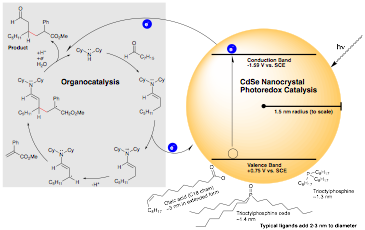Reports: ND156686-ND1: Heterogeneous Colloid Catalysts for Visible Light Photochemistry
Daniel J. Weix, PhD, University of Wisconsin, Madison
Todd D. Krauss, University of Rochester
The aim of this proposal is the development of efficient, low-cost colloidal catalysts for visible-light photocatalysis. The central hypothesis is that the properties that make these catalysts interesting for photovoltaics and biological imaging – excited state tunability, photochemical stability and robustness, high photoluminescence quantum yield – will enable them to be versatile catalysts for visible-light photocatalysis. Indeed, just prior to the beginning of this funding period, we accomplished one of the goals of our proposal, the validation of colloidal catalysts for visible light photoredox catalysis (Figure 1). We found that a single colloidal CdSe nanocrystal could mediate five different reactions, involving a range of substrates, additives, co-catalysts, and oxidation potentials (Figure 2). This work was published in J. Am. Chem. Soc. earlier this year and was highlighted in Science, Chemistry World, and Chemical & Engineering News.
Figure 1. Basic scheme showing use of colloidal semiconductor nanocrystals as photoredox catalysts.
Figure 2. Reactions that are catalyzed by a single type of CdSe nanocrystal.
These results should be considered a starting point for further improvements because the catalysts we used were off-the-shelf colloidal nanocrystals that had never been optimized for catalysis. In the next year, our work will be focused on the development of improved, tailored catalysts. This work will involve exploring how catalyst core composition and size can be optimized by correlating physical properties, such as colloidal catalyst conduction band energy or photoluminescence quantum yield, with catalytic performance. We will vary the redox properties of the colloidal catalyst by changing the size of the particles and by examining known colloidal particles made from other, more abundant, elements. Ligands can also play a critical role, by allowing or preventing access to the particle for electron transfer, by stabilizing the catalyst in solution, and by altering the redox properties of the particle itself.
This grant has been instrumental in the development of a new, cross-disciplinary direction for the research programs of both investigators. The results obtained under this grant will lay the foundation of a new field of research in organic synthesis and materials chemistry. Because this work involves disparate fields, the students trained on this grant gain valuable experience working across disciplines.













